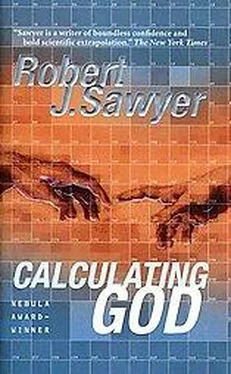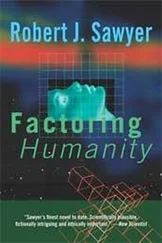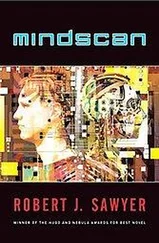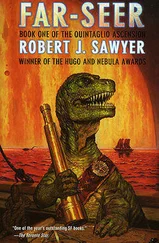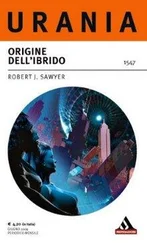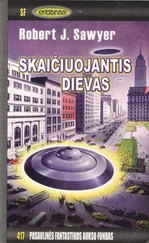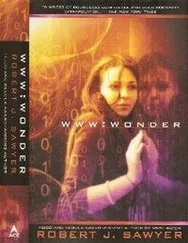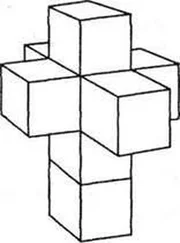Robert Sawyer - Calculating God
Здесь есть возможность читать онлайн «Robert Sawyer - Calculating God» весь текст электронной книги совершенно бесплатно (целиком полную версию без сокращений). В некоторых случаях можно слушать аудио, скачать через торрент в формате fb2 и присутствует краткое содержание. Город: New York, Год выпуска: 2000, Издательство: Tor Books, Жанр: Фантастика и фэнтези, на английском языке. Описание произведения, (предисловие) а так же отзывы посетителей доступны на портале библиотеки ЛибКат.
- Название:Calculating God
- Автор:
- Издательство:Tor Books
- Жанр:
- Год:2000
- Город:New York
- ISBN:нет данных
- Рейтинг книги:5 / 5. Голосов: 1
-
Избранное:Добавить в избранное
- Отзывы:
-
Ваша оценка:
- 100
- 1
- 2
- 3
- 4
- 5
Calculating God: краткое содержание, описание и аннотация
Предлагаем к чтению аннотацию, описание, краткое содержание или предисловие (зависит от того, что написал сам автор книги «Calculating God»). Если вы не нашли необходимую информацию о книге — напишите в комментариях, мы постараемся отыскать её.
Calculating God — читать онлайн бесплатно полную книгу (весь текст) целиком
Ниже представлен текст книги, разбитый по страницам. Система сохранения места последней прочитанной страницы, позволяет с удобством читать онлайн бесплатно книгу «Calculating God», без необходимости каждый раз заново искать на чём Вы остановились. Поставьте закладку, и сможете в любой момент перейти на страницу, на которой закончили чтение.
Интервал:
Закладка:
It only took a few seconds for the first glider to appear. “See that group of five cells?” I said. “We call that a ‘glider,’ and — ah, there’s another one.” I touched the screen, pointing it out. “And another. Watch them move.”
And, indeed, they did seem to move, staying a cohesive group as they shifted from position to position across the monitor.
“If you run this simulation long enough,” I said, “you’ll see all sorts of lifelike patterns; in fact, this game is called Life. It was invented in 1970 by a mathematician named John Conway; I used to use it when I taught evolution at U of T. Conway was astonished by what those three simple rules generated. After enough iterations, something called a ‘glider gun’ will appear — a structure that shoots out new gliders at regular intervals. And, indeed, glider guns can be created by collisions of thirteen or more gliders, so, in a way, the gliders reproduce themselves. You also get ‘eaters,’ which can break up passing objects; in the process, the eater gets damaged, but after a few more turns, it repairs itself. The game produces movement, reproduction, eating, growth, the healing of injuries, and more, all from applying those three simple rules to an initially random selection of pieces.”
“I do not see the point you are trying to make,” said Hollus.
“The point is that life — the apparent complexity of it all — can be generated by very simple rules.”
“And these rules you keep iterating represent precisely what?”
“Well, the laws of physics, say . . .”
“No one disputes that seeming order can come out of the application of simple rules. But who wrote the rules? For the universe you are showing me, you mentioned a name—”
“John Conway.”
“Yes. Well, John Conway is the god of that universe, and all his simulation proves is that any universe requires a god. Conway was the programmer. God was also a programmer; the laws of physics and physical constants he devised are our universe’s source code. The presumed difference between your Mr. Conway and our God is that, as you said, Conway did not know what his source code would produce until he compiled and executed it, and he was therefore astounded by the results. Our creator, one presumes, did have a specific result in mind and wrote code to produce that result. Granted, things have apparently not gone precisely as planned — the mass extinctions seem to suggest that. But, nonetheless, it seems clear that God deliberately designed the universe.”
“You really believe that?” I asked.
“Yes,” said Hollus, as he watched more gliders dance across my computer screen. “I really do.”
8
When I was a boy, I belonged to the Royal Ontario Museum’s Saturday Morning Club for three years. It was an incredible experience for a kid like me, fascinated by dinosaurs and snakes and bats and gladiators and mummies. Every Saturday during the school year, we’d go down to the museum, getting in before it opened to the public. We’d congregate in the ROM theater — that’s what it was called before some overpriced consultant had decided we should rename it Theatre ROM. It had been quite grotty back then, and upholstered entirely in black; it’s since had a face-lift.
The mornings would start off with Mrs. Berlin, who ran the club, showing us a 16 mm movie, usually some short from the National Film Board of Canada. And then we’d head off for a half-day of activities in the museum, not just in the galleries but also behind the scenes. I loved every minute of it and made up my mind that someday I would work at the ROM.
I remember one day we were getting a demonstration from the artist responsible for many of the museum’s dinosaur reconstructions. He asked our assembled group what kind of dinosaur a pointed, serrated tooth he was showing us had come from.
“A carnosaur,” I’d said at once.
The artist had been impressed. “That’s right,” he said.
But another kid berated me later. “It’s carni vore , he said, not carnosaur.
Carnosaurwas, of course, the correct word: it was the technical name for the group of dinosaurs that included tyrannosaurs and their kin. Most kids don’t know that; hell, most adults don’t know it.
But I knew it. I’d read it on a placard in the ROM’s Dinosaur Gallery.
The original Dinosaur Gallery, that is.
Instead of our current dioramas, that gallery had had specimens mounted so you could walk right around them; velvet ropes kept the public from getting too close. And each specimen had a lengthy, typed explanation in a wooden frame that would take four or five minutes to read.
The centerpiece of the old gallery was a Corythosaurus, a huge duckbill standing erect. There was something wonderfully Canadian, although I didn’t understand it as such at the time, about the ROM’s showcase dinosaur being a placid vegetarian instead of the ravenous T. rexes or the fiercely armed Triceratopses that were the major mounts at most U.S. museums; indeed, it wasn’t until 1999 that the ROM put a T rex cast on display, over in the kid’s Discovery Gallery. Still, that ancient Corythosaurus mount was wrong. We know now that hadrosaurs almost certainly couldn’t stand up like that; they probably spent most of their time as quadrupeds.
Every time I went to the museum as a kid, I made a point of looking at that skeleton, and the others, and reading the placards, and struggling with the vocabulary, and learning as much as I could.
We still have that skeleton at the ROM, tucked to the side of the Cretaceous Alberta diorama, but there’s no explanatory text associated with it anymore. Just a small Plexiglas sign that disingenuously glosses over the erroneous stance, and says little else:
Corythosaurus ExcavatusGilmore
A crested hadrosaur (duck-bill) mounted in an upright alert posture. Upper Cretaceous, Oldman formation (approximately 75 million years), Little Sandhill Creek, near Steveville, Alberta.
Of course, the “new” Dinosaur Gallery was a quarter-century old now. It had opened before Christine Dorati had come to power, but she considered it a model of what our displays should be like: don’t bore the audience, don’t weigh them down with facts. Just let them gawk.
Christine had a couple of daughters; they were grown now. But I often wondered if, when they were kids, she had been embarrassed at a museum. Perhaps she’d said, “Oh, Mary, that’s a Tyrannosaurus rex. It lived ten million years ago.” And her daughter — or, worse, some smart-aleck kid like I’d been — had corrected her with information that had been written on a lengthy placard. “That’s not a tyrannosaur, and it didn’t live ten million years ago. It’s an Allosaurus, and it lived 150 million years ago.” But whatever the reason, Christine Dorati hated signage that conveyed information.
I wish we had the money to redo the Dinosaur Gallery again; I’d inherited it in its current condition. But money was scarce these days; the axing of the planetarium was hardly the only cutback.
Still, I wondered how many kids we were inspiring these days.
I wondered—
It wouldn’t be my Ricky; that would be too much to ask. Besides, he was still at the stage where he wanted to be a firefighter or a police officer and had evinced no particular interest in science.
Still, when I looked at the tens of thousands of school-aged children who came on field trips to the museum each year, I wondered which if any of them would grow up to follow in my footsteps.
Hollus and I were at an impasse over the interpretation of the game of Life, and so I excused myself, and went to the washroom. As I always did, I opened the faucets on all three sinks, to make some background noise; the public washrooms at the ROM all had faucets controlled by electric eyes, but we didn’t have to put up with that indignity in the staff facilities. The running water drowned out the sound as I crouched down in front of one of the toilets and vomited; I tossed my cookies about once a week, thanks to the chemo drugs. It was hard on me; my chest and lungs were already strained. I took a few moments, kneeling there, just to regain my strength, then I stood up, flushed the toilet, and headed to the sinks, washing my hand and turning off all the taps. I kept a bottle of mouthwash at the museum and had brought it in with me; I gargled, trying to kill the foul taste. And, then, at last, I returned to the paleobiology department, smiling at Bruiser as if nothing unusual had happened. I opened the door to my office and went back inside.
Читать дальшеИнтервал:
Закладка:
Похожие книги на «Calculating God»
Представляем Вашему вниманию похожие книги на «Calculating God» списком для выбора. Мы отобрали схожую по названию и смыслу литературу в надежде предоставить читателям больше вариантов отыскать новые, интересные, ещё непрочитанные произведения.
Обсуждение, отзывы о книге «Calculating God» и просто собственные мнения читателей. Оставьте ваши комментарии, напишите, что Вы думаете о произведении, его смысле или главных героях. Укажите что конкретно понравилось, а что нет, и почему Вы так считаете.
